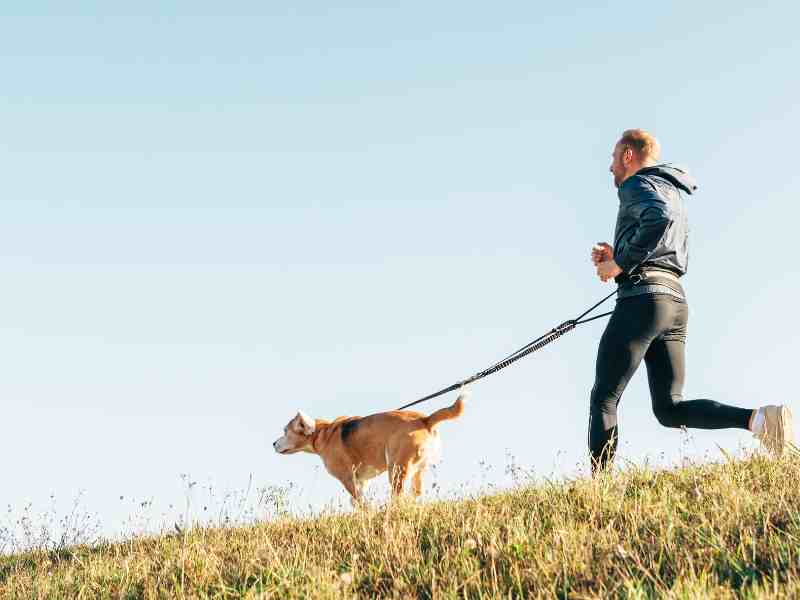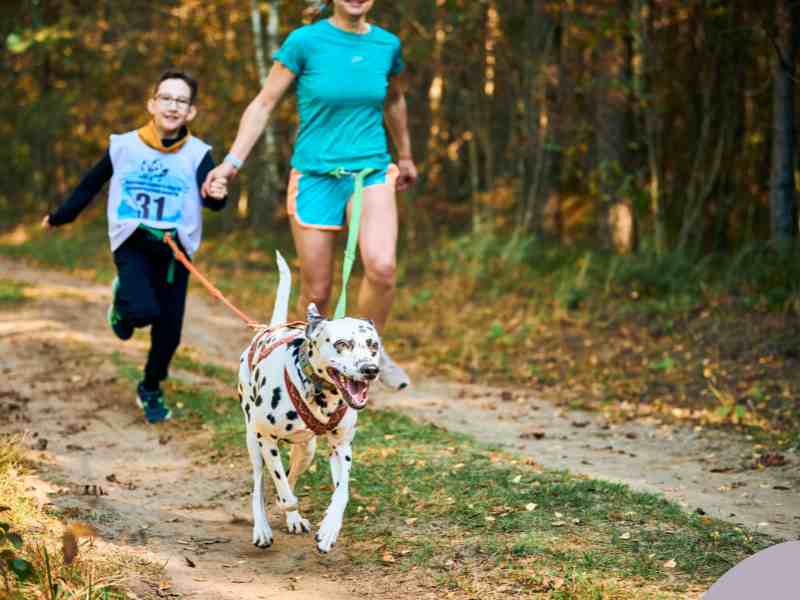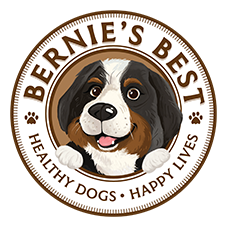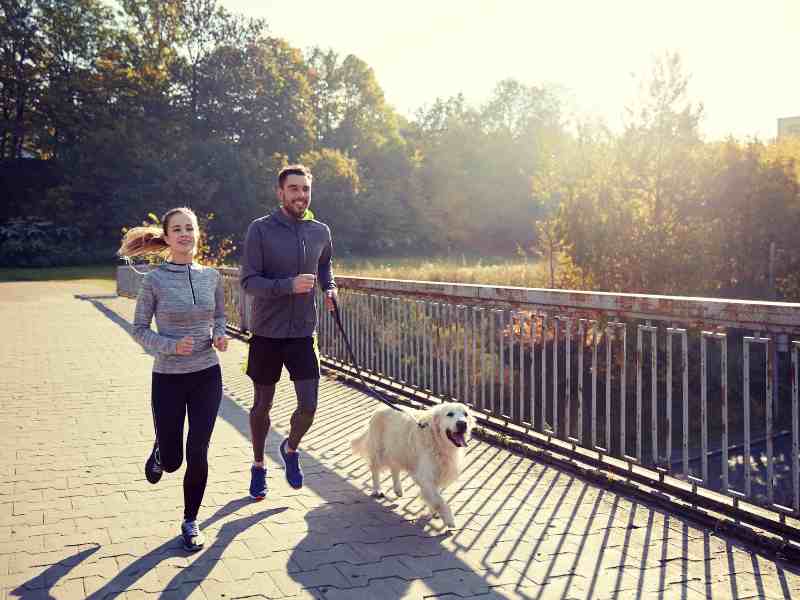Running with your dog is more than exercise; it’s a bonding experience that brings joy and health benefits to both of you. It’s a super popular exercise, but it’s important to make sure we’re being proactive with our dogs’ joints when we take them running. You can use several strategies to make sure there’s less risk of long-term damage, and that’ll let you enjoy more runs and adventures worry-free!
What’s So Great About Running With Your Dog?
Running isn’t just a workout for you; it’s a world of benefits for your dog, too. Nearly half the households in the U.S. have a dog, meaning pet parenting is more the norm these days. With numbers suggesting that there are over 48.2 million dog-owning homes in the United States, our furry friends are an integral part of our lives and our fitness routines.
So why run with your dog? The science backs it up; exercise isn’t just good for their body, it’s essential for their mind. Regular running can significantly enhance your dog’s cardiovascular health, keeping those heart muscles strong and efficient. It’s not just about the physical perks, though. The mental stimulation that comes from all the new scents, sights, and sounds on runs can help prevent them from getting bored and destructive. A well-exercised dog is usually a happier, less anxious and destructive dog, and that’s a win for you both!
Cardiovascular Benefits Of Running With Dogs
Regular aerobic activities like running are essential for maintaining good cardiovascular health in dogs, similar to offering the same benefits for humans. For dogs, consistent physical activity helps improve heart health, circulation, and overall endurance. The American Heart Association suggests that 150 minutes of moderate-intensity activity per week, like walking or running, can significantly benefit both humans and dogs. Participating in these activities with your dog can lead to improved muscular strength, better sleep, and reduced stress for both of you.
Mental and Behavioral Benefits Of Running With Dogs
Exercise has a super significant impact on a dog’s mental health, too. Physical activities trigger the release of brain-derived neurotrophic factor (BDNF), a protein that promotes the growth of new brain cells, especially in areas associated with learning and memory. Research shows that exercise increases the blood supply to the brain and supports the development of new neurons, enhancing cognitive functions. All that science simply means that regular exercise can help your dog stay sharp and mentally stimulated, and help them stay cognitively fit as they age.
Additionally, consistent exercise helps manage a dog’s energy levels, reducing hyperactivity and minimizing behavioral problems. Activities like running give an outlet for excess energy, which can help dogs be more chill and relaxed at home. Dogs that engage in regular physical activity often exhibit fewer signs of anxiety and stress, contributing to a happier and more balanced lifestyle.
Tailoring Exercise When Running With Your Dog
It’s important to remember that every dog is different, and the amount and type of exercise they need can vary based on their breed, age, and health status. Puppies, for example, require short bursts of activity to accommodate their growing bodies. At the same time, adult and senior dogs might need more or less exercise depending on their overall health and energy levels. It’s never a bad idea to check with your vet to see what they think about an exercise regimen for your dog. t’s appropriate for their
That said, some specific breeds were practically born to run. For instance, the Weimaraner, Vizsla, and Dalmatian have energy levels that skyrocket and stamina that can definitely outlast your playlist. These breeds, among others tailored for lots of activity, often thrive on the physical exertion that running with them offers. However, it’s important to consider your dog’s size and breed since those over 80 pounds may face a higher risk of joint issues, and running on hard surfaces could exacerbate these problems.
Not all dogs are built the same. While the allure of pounding the pavement with your pooch is strong, it’s essential to tailor your running routine to their needs, considering their breed, size, and health to ensure those miles bring smiles, not strains.
Factors To Consider When You Run With Your Dog
Before lacing up and hitting the pavement with your furry best friend, it’s really important to consider a few key factors that could impact their health and enjoyment of running. Taking these considerations into account will help make sure that your running sessions are both safe and beneficial for your dog.
Age: Running with Puppies and Senior Dogs
- Puppies: Their bodies are still developing, and their joints are more vulnerable. High-impact exercise like running can lead to injuries or joint problems. Short, playful exercise sessions are more suitable for puppies, allowing them to stop when tired. Always consult your vet to understand when it’s safe to start running with your puppy, as this can vary by breed. Generally speaking, though, experts advise against anything that may impact a puppy’s growth plates being affected.
- Senior Dogs: Age doesn’t just bring wisdom; it often comes with arthritis or other age-related conditions that can make running uncomfortable or even harmful. Gentle walks or short, slow jogs on soft surfaces, tailored to their comfort level, are better options. Regular vet check-ups may help monitor their health and guide the appropriate level of activity, but when in doubt, if they seem in pain, take it down a notch.
Breed: Understanding Breed-specific Exercise Needs
Different breeds have varying levels of energy and physical capabilities. For instance:
- High-energy Breeds: As we mentioned, dogs like Border Collies, Vizslas, and Dalmatians often thrive on more intense exercise and can make excellent running partners for longer distance running.
- Breeds with Joint Issues: Some large breeds, such as German Shepherds and Labradors, are more prone to hip dysplasia and other joint problems. Running on hard surfaces or for extended periods can exacerbate these issues.
- Brachycephalic Breeds: Dogs with short noses (like Pugs and Bulldogs) can have difficulty breathing, especially during intense exercise. Short, leisurely walks are safer and more comfortable for them.
Understanding your dog’s breed-specific needs can help tailor an exercise routine that keeps them healthy and happy without risking injury. Each dog is different and finding what works best for your dog’s best health is always the goal.
Pre-existing Health Conditions
Dogs with pre-existing health conditions require special consideration when it comes to exercise:
- Heart Conditions: Dogs with heart problems may need limited exercise; your vet can provide guidance on how much and what type of activity is safe.
- Respiratory Issues: Similarly to brachycephalic breeds, dogs with respiratory issues may struggle with strenuous exercise. It’s important to keep runs short and in cooler temperatures, and to monitor for any signs of distress.
- Obesity: Overweight dogs benefit from exercise to help shed the extra pounds, but it’s important to start slowly and gradually increase the intensity and duration of runs to avoid putting too much strain on their joints.
Regular check-ups with your vet may help you stay informed about your dog’s health status and any pre-existing conditions they might have. The key thing is to pay attention to these factors – age, breed, and pre-existing health conditions – so that you can create a running plan that is both enjoyable and beneficial for your dog.
How To Run With Your Dog: The Starting Line
Starting a running journey with your dog is an excellent way to keep both of you healthy and happy. However, before you hit the road or trail, there are several key considerations that will help make sure it’s a safe and enjoyable experience. Here’s a guide to get you both off to a great start.
Start Slow
- Why it’s important: Dogs, like humans, need to build up their endurance gradually to avoid injury.
- What to do: Begin with short distances and slow speeds. Observe how your dog responds and gradually increase the distance and pace based on their comfort and capability.
Pay Attention to Weather
- Why it’s important: Extreme temperatures can be harmful. Hot weather poses a risk of overheating, while cold conditions can lead to hypothermia or frostbite, especially in short-haired breeds.
- What to do: Choose cooler parts of the day to run during hot weather and make sure your dog is appropriately equipped for cold conditions.
Hydration and Nutrition
- Why it’s important: Running increases the need for hydration and may also impact nutritional requirements. A lot of dogs don’t get enough water as it is; be sure they get more when exercising.
- What to do: Ensure your dog can access clean water before, during, and after runs.
Leash and Gear
- Why it’s important: A good leash and harness setup can improve control and comfort for both you and your dog.
- What to do: Opt for a hands-free running leash that attaches around your waist and a comfortable, snug harness for your dog. This setup leaves your hands free and provides better control and security for your dog.
Paw Care
- Why it’s important: Rough or hot surfaces can quickly damage your dog’s pads.
- What to do: Regularly check your dog’s paws for signs of wear or injury, and consider protective booties if you’ll be running on hot pavement or rough trails. If you regularly run with your dog, consider a good paw balm as a daily support.
Pay Attention to Your Dog
- Why it’s important: Dogs will often keep going to please their owners, even if they are tired or uncomfortable. It’s easy to miss the signs they are fatigued if you’re not watching for them.
- What to do: Watch for signs of fatigue or discomfort in your dog, such as heavy panting, slowing down, or limping, and be ready to stop if needed.
Training for Behavior
- Why it’s important: Good manners are essential for safety and enjoyment when running in public spaces.
- What to do: Train your dog to respond to commands, stay by your side, and not pull on the leash. This may take some practice and patience. Lots of it.
Plan for Emergencies
- Why it’s important: Accidents can happen, and it’s best to be prepared.
- What to do: Carry a basic first-aid kit for you and your dog, and have a plan for getting back home in case of injury.
Enjoy the Bonding Experience!
- Why it’s important: Running together is not just about physical health but also about strengthening the bond between you and your dog.
- What to do: Use this time to enjoy being together, explore new routes, and make running a fun and rewarding experience for both of you.
Understanding Dog Joint Health And Running
Understanding a bit about canine joint health is important for ensuring the well-being of our dogs. Just like humans, dogs can suffer from various joint disorders that can affect their quality of life.
Basics of Canine Joint Health
Joints in dogs function as pivot points for movement and are crucial for mobility. They are complex structures made up of bone, cartilage, synovial fluid, muscles, and tendons. The health of these components is essential for smooth and pain-free dog movement. Maintaining joint health involves proper nutrition, regular exercise, and monitoring for signs of distress or discomfort.
Importance of Joint Health
Healthy joints are vital for dogs of all ages to lead active, happy lives. Joint issues can significantly impact a dog’s ability to perform everyday activities. This can lead to a decrease in the quality of their life. Early detection and management of joint problems can help mitigate long-term damage, reduce pain, and maintain mobility. It’s all about quality of life when it comes to joint pain and joint health in dogs.
Common Joint Problems
- Osteoarthritis (OA): Also known as degenerative joint disease, OA is prevalent in dogs, especially as they age. It involves the breakdown of cartilage in the joints, leading to pain, stiffness, and reduced mobility. Up to 75% of medium-sized and large adult dogs are affected by OA. Some research suggests a need for early screening and management to improve their quality of life and functional activity.
- Hip Dysplasia: This is a genetic condition that’s characterized by a malformation of the hip joint, which leads to loose or lax joints and possible injury. It’s particularly common in larger breeds and can result in arthritis, pain, and lameness. Hip dysplasia is unfortunately more prevalent in certain breeds than it is in others, so if you have a dog that’s prone to hip dysplasia, consider that when you’re considering running with them.
- Elbow Dysplasia and Cruciate Ligament Disease: These conditions are among those that can lead to secondary OA. That’s why early detection and intervention for joint health matters so much.
Factors Influencing Joint Health
Research has identified several key factors influencing the risk of developing joint disorders in dogs. Genetics plays a significant role, with certain genes being associated with an increased risk of joint diseases. Additionally, breed and body conformation are important, as specific breeds and body types are predisposed to joint problems due to the physical demands placed on their joints or inherited traits.
Body weight is another critical factor, with obesity increasing the risk of developing joint disorders. Managing your dog’s weight through diet and exercise can significantly reduce this risk. Also super important is ensuring they’re getting proper nutrition, including the use of joint supplements to help slow the progression of joint diseases and support overall joint health.
Dog joint health can be complex, but a proactive and educated approach to managing it can make all the difference. Ensuring they’re getting optimal nutrition, maintaining a healthy weight, and being vigilant about your dog’s mobility and behavior are key to supporting their health.
Protecting Your Dog’s Joints During Runs
To protect your dog’s joints during runs, it’s important to have a proper routine that includes warm-up and cool-down exercises, choosing appropriate running surfaces, and being able to recognize signs of overexertion or joint pain. Here are some strategies to keep your dog’s joints safer:
Warm-Up and Cool-Down Routines for Your Dog:
- Why it’s important: Warming up prepares your dog’s body for exercise by increasing blood flow to the muscles, and cooling down helps to lower the heart rate and reduce muscle stiffness gradually.
- What to do: Start with a leisurely walk that gradually increases in speed to a light jog. This can last about 5 to 10 minutes. After the run, a similar cool-down period helps the body transition back to a resting state.
Choosing the Right Surfaces to Run On:
- Why it’s important: Some surfaces can be really harsh on your dog’s joints, leading to increased wear and tear.
- What to do: Look for softer surfaces, such as grass or dirt trails, which are more forgiving than asphalt or concrete. If you’re running in an urban area, try to find a park or a grassy path to provide some relief for your joints.
Recognizing Signs of Overexertion and Joint Pain in Dogs:
- Why it’s important: Dogs are not always able to communicate discomfort until it’s quite severe. Often, they’ll continue in initial pain just to please you. Recognizing early signs of pain can prevent long-term damage.
- What to do: Watch for limping, reluctance to continue running, lagging behind, swelling of the joints, or licking a particular joint excessively. If any of these signs are present, stop the activity and consider talking to your vet.
How To Maintain Long-term Joint Health For Dogs
Implementing these practices can significantly reduce the risk of joint injuries and can contribute to a healthier and more enjoyable running experience for your active dog. It’s important to remember that individual dogs have unique needs based on age, breed, and health status, so tailored approaches are the best.
Focusing on a holistic approach that includes nutrition, lifestyle, and supplementation can be highly effective for long-term joint health maintenance in dogs. A balanced diet that provides a range of joint-supporting nutrients is really what sets the foundation for healthy joints. Nutrients like omega-3 fatty acids, which are found in flaxseed, anchovy, and algal oil, are essential for their anti-inflammatory properties. Antioxidants from sources like astaxanthin and blueberries help combat oxidative stress, which can damage joint tissues. Additionally, anti-inflammatory compounds from herbs such as turmeric and boswellia can support joint function and comfort.
When considering supplements, it’s important to look for products that contain well-researched ingredients known for their efficacy in supporting joint health. Combining ingredients like Undenatured type-II collagen for cartilage health, green-lipped mussels rich in beneficial compounds, and omega-3 fatty acids for their anti-inflammatory effects can offer your dog comprehensive joint support. Additionally, maintaining a healthy weight and promoting a lifestyle that includes regular, appropriate exercise can help keep your dog’s joints healthy.
Focusing on prevention through a clean, nutrient-rich diet and the right supplementation can help maintain your dog’s joint health over the long term, especially if you’re taking them on runs with you. Responsible supplementation with a healthy lifestyle may even reduce the need for frequent vet visits due to joint issues.
Bernie’s Marvelous Mobility: Daily Maintenance For Every Dog Running
As a small, family-owned business, we understand that your dog isn’t just a pet; they’re part of the family. We share your passion for staying active and fostering a bond through running and other adventures–it’s what we do with our own dogs. Our focus at Bernie’s Best is about creating solutions that nurture a healthy lifestyle and ensure longevity for our dogs because they’re family.
With Marvelous Mobility, we’re proud we offer a product formulated from the ground up with your dog’s joint health in mind. We packed it with nature’s best ingredients, like Omega-3s from flaxseed, anchovy, and algal oils, antioxidants from astaxanthin and blueberries, and anti-inflammatories from turmeric and green-lipped mussels, because we’re committed to supporting your dog’s well-being from the inside out.
We’re fellow pet parents who want the best for our dogs, too. At the end of the day, it’s about more than just joint health—it’s about more years of companionship, more adventures, and more memories made with every run you and your best friend take together.


